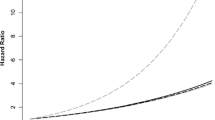Abstract
Background: Older patients mostly receive depression care from primary care physicians, but it is not known whether depression treatment is primarily received from family/general practice physicians or internal medicine physicians and whether the type of depression treatment offered varies between these types of primary care physicians.
Objective: To assess what proportion of visits for depression are to family/general practice physicians or to internal medicine physicians and whether the type of depression treatment offered varies by primary care physician specialty.
Design: Data from the 2000 and 2001 National Ambulatory Medical Care Surveys, a nationally representative survey of visits to office-based practices using clustered sampling, were used.
Participants: Office-based physician practices in the United States.
Results: There were an estimated 9.8 million visits made to office-based providers by older patients for depression in 2001 to 2002, of which 64% were to primary care physicians. Visits to primary care providers were evenly split between Internists and family/general practice physicians. There was no significant difference in the rate of antidepressant prescribing between visits to Internists versus family/general practice (55.9% vs 48.0%;P=.42). Mental health counseling or psychotherapy was offered more often during visits to family/general practice physicians than to Internists (39.4% vs 14.0%;P=.07).
Conclusions: Visits for depression by elderly patients continue to take place in primary care settings to both family/general practice physicians and Internists. Interventions aimed at improving depression care in primary care should focus on both types of primary care physicians and emphasize improving rates of diagnosis and referral for counseling or psychotherapy as a viable treatment option.
Similar content being viewed by others
References
Lebowitz B. Diagnosis and treatment of depression in late life: an overview of the NIH consensus statement. Am J Geriatr Psychiatry. 1996;4(suppl):S3-S6.
U.S. Department of Health and Human Services. Mental Health: A Report of the Surgeon General. Rockville, MD: U.S. Department of Health and Human Services, Substance Abuse and Mental Health Services Administration, Center for Mental Health Services, National Institutes of Health, National Institute of Mental Health; 1999.
Lyness JM, King DA, Cox C, et al. The importance of sub-syndromal depression in older primary care patients. J Am Geriatr Soc. 1999;47:647–52.
Frasure-Smith N, Lesperance F, Talajic M. Depression and 18-month prognosis after myocardial infarction. Circulation. 1995;91:999–1005.
Penninx W, Penninx H, Guralnik J, et al. Depressive symptoms and physical decline in community dwelling older persons. JAMA. 1998;279:1720–6.
Penninx BWJH, Geerlings SW, Deeg DJH, et al. Minor and major depression and the risk of death in older persons. Arch Gen Psychiatry. 1999;56:889–95.
Rovner B, German P, Brant L, et al. Depression and mortality in nursing homes. JAMA. 1991;265:993–6.
Unutzer J, Patrick D, Simon G, et al. Depressive symptoms and the cost of health services in HMO patients aged 65 and older. JAMA. 1997;277:1618–23.
Harman JS, Kelleher KJ, Pincus HA, et al. Out-of-pocket health care expenditures of older persons with depression. J Am Geriatr Soc. 2004;52:809–13.
Roose S, Schatzberg A. The efficacy of antidepressants in the treatment of late-life depression. J Clin Psychopharmacol. 2005;25:S1-S7.
Reynolds CF III,Frank E, Perel JM, et al. Nortriptyline and interpersonal psychotherapy as maintenance therapies for recurrent major depression. A randomized controlled trial in patients older than 59 years. JAMA. 1999;281:39–45.
Unutzer J, Katon W, Sullivan M, et al. Treating depressed older adults in primary care: narrowing the gap between efficacy and effectiveness. Milbank Q. 1999;77:225–56.
Young AS, Klap R, Sherbourne CD, et al. The quality of care for depressive and anxiety disorders in the United States. Arch Gen Psychiatry. 2001;58:55–61.
Unutzer J, Simon G, Belin TR, et al. Care for depression in HMO patients age 65 and older. J Am Geriatr Soc. 2000;48:871–8.
Harman JS, Edlund MJ, Fortney JC. Disparities in the adequacy of depression care in the United States. Psych Serv. 2004;55:1379–85.
Harman JS, Crystal S, Walkup J, et al. Trends in elderly patients’ office visits for the treatment of depression according to physician specialty: 1985–1999. J Behav Health Serv Res. 2003;30:332–41.
Pincus HA, Tanielian TL, Marcus SC, et al. Prescribing trends in psychotropic medications: primary care, psychiatry, and other medical specialities. JAMA. 1998;279:526–31.
Crystal S, Sambamoorthi U, Walkup JT, et al. Diagnosis and treatment of depression in the elderly medicare population: predictors, disparties, and trends. J Am Geriatr Soc. 2003;51:1718–2.
Kessler RC, Berglund P, Demler O, et al. The epidemiology of major depressive disorder: results from the National Comorbidity Survey Replication (NCS-R). JAMA. 2003;289:3095–10.
Bruce ML, Ten Have T, Reynolds CF, et al. Reducing suicidal ideation and depressive symptoms in depressed older primary care patients: a randomized controlled trial. JAMA. 2004;291:1081–9.
Unutzer J, Katon W, Callahan CM, et al. Collaborative care management of late-life depression in the primary care setting: a randomized controlled trial. JAMA. 2002;288:2836–45.
Harman JS, Schulberg HC, Mulsant BH, et al. Effect of patient and visit characteristics on diagnosis of depression in primary care. J Fam Prac. 2001;50:1068.
Cherry DK, Woodwell DA. National Ambulatory Medical Care Survey: 2000 Summary. Advanced Data from Vital and Health Statistics. Hyattsville, MD: National Center for Health Statistics; 2002.
Bryant E, Shimizu I. Sampling design, sampling variance, and estimation procedures for the National Ambulatory Medical Care Survey. Vital Health Stat 2. 1988;108:1–39.
Stata Corporation. StataCorp: Stata Statistical Software: Release 7.0 Special Edition. College Station, TX: Stata Corporation; 2002.
Katon W, Schulberg H. Epidemiology of depression in primary care. Gen Hosp Psychiatry. 1992;14:237–4.
Leon A, Olson M, Broadhead W, et al. Prevalence of mental disorders in primary care: implications for screening. Arch Fam Med. 1995;4:857–61.
Pinquart M, Duberstein PR, Lyness JM. Treatments for later life depressive conditions: a meta-analytic comparison of pharmacotherapy and psychotherapy. Am J Psychiatry, in press.
Author information
Authors and Affiliations
Corresponding author
Additional information
None of the authors have any conflicts of interest to declare.
This research was supported by NIMH Grant K01 MH63780.
Rights and permissions
About this article
Cite this article
Harman, J.S., Veazie, P.J. & Lyness, J.M. Primary care physician office visits for depression by older Americans. J GEN INTERN MED 21, 926–930 (2006). https://doi.org/10.1007/BF02743139
Received:
Revised:
Accepted:
Issue Date:
DOI: https://doi.org/10.1007/BF02743139




